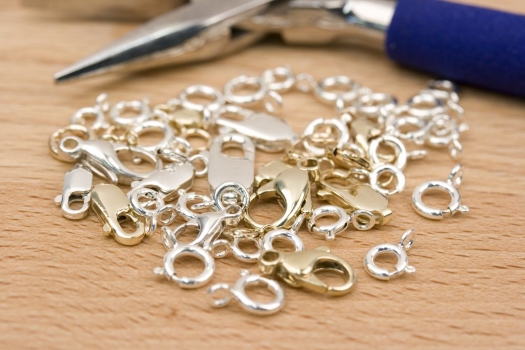There are many types of jewellery clasps that come in all shapes, sizes and price points. Various types of necklace clasps and other bracelet clasp types are available, with Cooksongold stocking over 500 different types of jewellery clasps in a number of styles and alloys – so where do you start and how do you pick a clasp for your jewellery making project?
Well, there is really no definitive answer when it comes to choosing a clasp, as in most situations a few different types of jewellery clasps would adequately do the job. However, the right choice should be based on three main factors; size/weight, price and aesthetics, so here is a summary of some of the most popular types of jewellery clasps available, along with their pros and cons.
What is a bolt ring clasp?
Bolt ring clasps provide a safe way to secure necklaces and bracelets. They simply consist of a loop with a small side lever that opens and closes them. You’ll see them everywhere. Why? They’re functional, affordable and extremely lightweight – hence their popularity on pendant chains.


You do need to be careful with them, however. Heat can ruin the lever mechanism. And the smaller sizes can be difficult to open and close for anyone affected by dexterity issues. Sizes range from 5mm to 22mm – which is much heavier and typically used for decoration only.
Shop our range of bolt ring clasps today.
What is a lobster clasp?
Lobster clasps (also known as lobster catches) are stronger, heavier and more expensive than bolt ring clasps. They’re spring-operated fasteners that resemble a lobster’s claw (hence the name) and can be opened and closed with a small lever.


The durability means they’re often used with expensive pieces, or where there’s a heavier pendant or a longer chain. Effectively the weight of the chain offsets the weight of the clasp. They’re not suitable for lightweight jewellery chains or bigger jump rings – which can restrict functionality. Sizes range from 7mm to 18mm.
Shop our range of lobster clasps today
What is a trigger clasp?
Trigger clasps aren’t too dissimilar to lobster clasps – they feature a spring mechanism which opens and shuts the catch when the lever is pulled. However, the big difference is in aesthetics. More rounded, often baroque in shape, they also feature a more generous opening – allowing for better functionality with a bigger jump ring.


They can be quite heavy, which makes them more expensive, but also a better choice for heavier weight chains and pendants – to provide balance. Sizes for trigger clasps range from 7mm to 18mm.
Shop our range of trigger ring clasps today.
What is a magnetic clasp?
Magnetic clasps on bracelets and necklaces feature concealed magnets – usually hidden in a decorative case. When placed together, they lock magnetically. These types of necklace clasps are usually spherical or elliptical. With them being so easy to open and close, they’re ideal for partially sighted people or anyone with dexterity problems.


They’re not the cheapest or lightest option around – hence why you’ll often see them used to attach beautiful strings of beads or pearls in expensive pieces. The weight and size of your necklace or bracelet is so important with magnetic clasps, so, if possible choose in person to avoid any costly mistakes.
Shop our range of magnetic ring clasps today.
What is a sliding clasp?
Sliding clasps are a relatively new concept in jewellery. They contain a silicone insert with a small hole in the centre, which will grip anything that is pushed through it, thus completing the loop and securing the piece.


They’re commonly used on casual beaded bracelets and necklets, as they allow the size to be easily adjusted. To work well, sliding clasps do require a bulkier chain with a substantial end – so the silicone can grip the surface as the chain passes through the clasp. Snake, box or bead chain all work effectively.
Shop our range of sliding clasps today.
What is an Albert swivel clasp?
Albert swivel clasps take their name from Price Albert – consort to Queen Victoria from 1837 to 1901. They’re designed for the end of pocket watch chains. The swivelling functionality allows wearers to check their watches without the chain getting twisted and tangled.
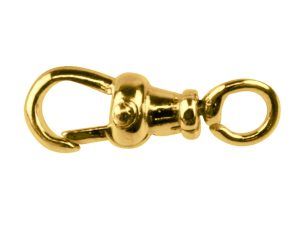

They’re most commonly used alongside objects that require full manoeuvrability, like key rings and bag charms. Be careful though – many ‘swivel clasps’ are sold with a fixed top, so don’t actually swivel at all. Sizes range from 13mm to 29mm.
Shop our range of Albert swivel clasps today.
What is a hook and ring clasp? What is a T-bar and ring clasp?
Although different types of clasps, we’ve grouped them together because they work in the same way. Once the hook or T bar is inserted into the ring, the weight of the necklace pulls the findings in opposite direction to secure them.
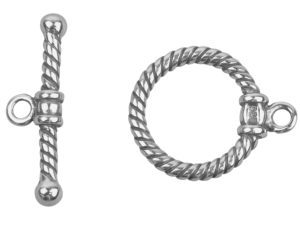

T bar and ring clasps come in many different styles. You just need to ensure there’s enough of an overlap of the ring, and that the necklace or bracelet is heavy enough to pull the clasp secure. Hook and ring clasps are better suited for lighter pieces with a more delicate fitting.
Shop our range of hook and ring and T bar and ring clasps today.
What is a padlock clasp?
Padlock clasps are most commonly found on heavyweight curb chain bracelets accompanied by a safety chain. The semi-circular bar at the top of the design is opened by gently pushing your finger against the protruding post alongside it, and pulling upwards in a lever motion.
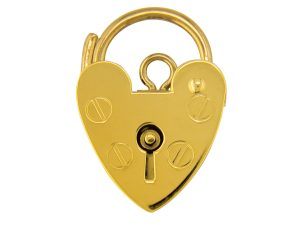

Once opened, both ends of your necklace or bracelet can be looped over the bar and snapped shut. You’ll often see padlock clasps paired with a short safety chain, attached to both ends of the piece and threaded through a loop at the top of the design. So, if the clasp were to open, your jewellery piece would remain attached.
Naturally, with such an elaborate aesthetic, they’re usually a focal point on a piece of jewellery. They’re also quite heavy, so it’s important to pair them with a heavy gauge chain – such as a heavyweight curb chain.
Shop our range of padlock clasps today.
What is a bayonet clasp?
Bayonet clasps have a very modern, minimalist look. With a simple push and twist action, two pieces of tube lock into place to provide a secure fixing mechanism. They’re suitable for light to medium weight pieces of jewellery.
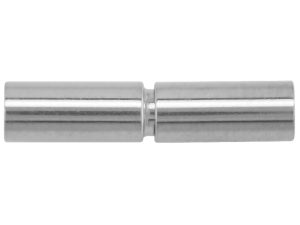

Loops can either be soldered to the end of each side or alternatively, lengths of rubber or leather can be glued into place as each piece of tube has been left unsealed. The bayonet clasp has lovely clean, uncomplicated lines so, it’s perfect for finishing contemporary, streamlined jewellery designs – without distracting from the main feature itself.
Shop our range of bayonet clasps today.
What is a multi-strand clasp?
Multi-strand clasps featured multiple open holes, through which layered chains can be threaded and secured. Usually, you’ll have clasps that can accommodate two, three or four rows of layered chains.
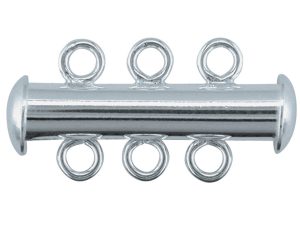

This type of jewellery clasp is very easy to use and provides a great way to fasten and secure multiple strand necklaces or bracelets. When using a multi-strand clasp, you just need to consider the width of your design – spacing on the clasps can vary.
For example, larger designs might require a bigger gap between the loops on your chosen clasp so that the separate strands lay flat.
Shop our range of multi-strand clasps today.
Discover Cooksongold’s full range of jewellery findings
Now you know more about the different jewellery clasp types, why not discover the vast range of other types of jewellery findings we stock here, at Cooksongold? Want to learn more about findings? Check out our Essential Guide to Jewellery Findings, which details everything from jump rings to collets to cufflink backs.
Find fine jewellery clasps at Cooksongold
Now you know more about the more basic styles and types of clasp, why not read part 2 and part 3 of this guide to learn more about other types of clasps? Or check out our Essential Guide to Jewellery Findings to discover the many other types of jewellery findings available.


Cooksongold

